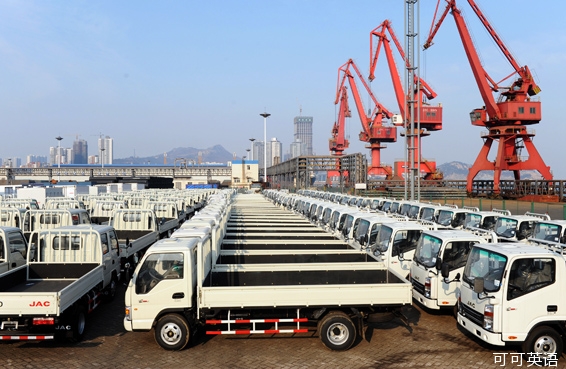
China, with frustrating predictability, has served up another February conundrum for the global economy, publishing data that confuse more than they clarify.
中国发布了令人困惑的程度超过指点迷津作用的数据,从而以令人沮丧的“可预测性”再度给全球经济带来“2月难题”。
It is a ritual that plays out at the start of every year but with one crucial difference as time goes by: now, more than ever, China’s difficult-to-decipher numbers have the ability to hold companies and investors around the world in their thrall. There are widespread concerns about Chinese growth in the wake of its financial turbulence, but as yet there is little solid evidence of how the economy is actually faring.
每年年初都会出现这种局面,但随着一年又一年过去,现在有了一个很大的不同:如今世界各地的企业和投资者空前关注着中国难以解读的经济数据。在中国金融业出现动荡之后,人们普遍担忧中国经济增长,但至今找不到反映实际经济表现的可靠证据。
The latest riddle comes in the form of China’s January trade numbers, published yesterday. Analysts had forecast them to be flat or even negative. Instead, they came in well above expectations, with exports up 10 per cent from a year earlier and imports up 10.6 per cent.
最新的不解之谜是昨日发布的中国1月贸易数据。分析师们此前预计这些数据将持平,甚至出现下降。可实际公布的数据远高于预期:1月中国出口同比增长10%,进口同比增长10.6%。
All else being equal, this would be taken to mean that both Chinese growth and global demand were a lot stronger than anticipated. Unfortunately, all else rarely is equal – and never is that truer than for Chinese economic data printed in February.
在其它条件相同的情况下,这将被理解为中国经济增长和全球需求都远比预期更为强劲。不幸的是,其它条件相同的情况很少发生——中国在2月份发布的经济数据尤其如此。
“We’re flying blind and nobody knows how to properly adjust this data,” said Stephen Green, head of China research with Standard Chartered. Then, with a chuckle: “We should all just take an extended holiday.”
“我们像是在黑暗中飞行,没有人知道如何恰当调整这些数据,”渣打(Standard Chartered)大中华区研究部主管王志浩(Stephen Green)表示。随后他笑着说:“我们都应该休一个长假。”
The culprit for the confusion is the Chinese new year, which causes two problems.
混乱的根源在于农历新年。它会导致两个问题。
First, because the week-long holiday is based on the lunar calendar, its timing changes from year to year, making for fraught comparisons. This year, the holiday began on the last day of January. In 2013 it began 10 days later.
首先,由于这个为期一周的假期是根据农历来安排的,其具体日期每年有所不同,给对比带来极大困难。今年的春节假期始于1月的最后一天。2013年的春节假期要晚10天。
Many analysts had expected that the loss of one working day this January would weigh on China’s economic activity for the month, making it appear weaker whether assessed in year-on-year or month-on-month terms.
许多分析师此前预计,今年1月损失一个工作日,将拖累该月中国的经济活动,使其在年度同比或月度环比基础上得到评估时都显得更为疲弱。
But after the upside surprise in the trade data, the exact opposite explanation was in vogue – namely, that the earlier timing of the holiday might in fact have inflated figures. “Today’s strong export report could have been boosted by a rush of shipments ahead of the Chinese new year,” economists with Barclays wrote in a note.
但在贸易数据超出预期之后,完全相反的解释占了上风,即,春节假期较早也许实际上夸大了1月份的数据。“今日的强劲出口数据可能得到企业赶在农历新年之前发货的提振,”巴克莱(Barclays)经济学家在一份简报中写道。
The second problem is that much of China grinds to a halt for the new year holiday, and not just for one week. With hundreds of millions of migrant labourers travelling home, many factories shut for the better part of a month and offices run at half-speed.
第二个问题是,中国经济中相当大的一部分活动在春节前后嘎然而止,其持续时间不止一周。随着数以亿计的农民工回家过年,许多工厂要关闭大半个月,办公室的运转速度也大幅减缓。
It is enough to confound statisticians. Rather than offer up skewed data, they wait until March to collate together the figures from January and February for retail sales, industrial output and fixed-asset investment.
这足以让统计人员一头雾水。与其提供扭曲的数据,他们干脆等到3月份,然后合并整理1、2月的零售销售、工业产出和固定资产投资数据。
Those combined figures for the first two months of the year are more reliable since they get around the problem of the timing of the new year holiday, but the delay does not make life easy for analysts or investors. It means that they need to rely on a tiny array of distorted data points – purchasing manager indices, bank loans, trade and inflation – to draw conclusions about the world’s fastest-growing major economy.
年初头两个月的合并数据更为可靠,因为他们避免了农历新年日期不固定的问题,但延后发布数据并不能让分析师或投资者的日子好过,因为他们只能依赖少量的扭曲数据——采购经理人指数(PMI)、银行贷款、贸易和通胀——得出关于全球增长最快的大型经济体的结论。
“This is the time to get out and do a little more tyre-kicking,” said Helen Qiao, an economist with Morgan Stanley.
摩根士丹利(Morgan Stanley)经济学家乔虹(Helen Qiao)表示,这个时候的数据也就是姑且一看。
Along with field trips to speak with companies, bankers and officials, she suggested checking “bottom-up” numbers such as shipping volumes and raw-material prices.
除了实地考察,与企业、银行家和官员交谈外,她建议关注“自下而上”的数字,如运输量和原材料价格。
China’s headline data for January have so far pulled in different directions. Weak PMI surveys for the manufacturing and service sectors had stoked worries about Chinese growth – they were cited as one of the biggest reasons for the sell-off in global equities last month. However, yesterday’s strong trade data reinforced the more optimistic mood that has prevailed in recent days. Inflation and lending figures will be released later this week.
中国1月份的整体数据迄今表现各异。制造业和服务业PMI调查数据疲弱,令人担忧中国经济放缓——这些数据被称为上月全球股市抛售的主要原因之一。不过,昨日发布的强劲贸易数据,助长了近日占上风的比较乐观的情绪。本周晚些时候将发布通胀和放贷数据。
But it will not be until March, when a full set of cleaner data are published, that a sharper picture of the Chinese economy will emerge. Until then, it could well be a nervous wait.
但是,有关中国经济的更清晰画面要到3月份全套干净数据发布后才会显现。从现在到那时很可能会是一段紧张的等待期。


